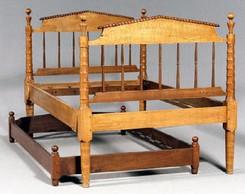 When many people see trundle beds, they think of Little House in the Big Woods. They may also think of impoverished people, frontier living, too many people and not enough room. In reality, trundle beds have been around far longer and have a very different tradition in history.
When many people see trundle beds, they think of Little House in the Big Woods. They may also think of impoverished people, frontier living, too many people and not enough room. In reality, trundle beds have been around far longer and have a very different tradition in history.
But first, to define them: trundle beds (also sometimes called truckle beds) derive their name from little wheels or casters that allowed them to be “trundled” out of the way. (The word has its roots in an Old English word, trendan, which means to revolve.) They’re simply smaller, lower beds that can be pushed or “trundled” under the larger, main bed, leaving space free during the day or during longer periods when an additional bed isn’t required.
While as mentioned some of the strongest associations tend to be with the 19th century and frontier life, a transition they may have gradually made during their use in America, but in Europe, trundle beds were actually in use as early as the 1600s and were actually in use in more prosperous homes, where they were occupied by servants. For example, Samuel Pepys, he of the exhaustive diaries, occasionally mentions that their servant slept in their room on a trundle bed. The European tradition of a trundle bed is rooted in the homes of those wealthy enough to have personal servants – maids and valets – who slept at hand during the night, in case the fire needed fed, the chamber pot needed emptied, etc. Trundle beds were tucked away and easily hidden in the heavy drapes and bed curtains on the beds of the prosperous.
They were occasionally used that way in wealthy homes in America too, and it isn’t hard to imagine an invalid or a woman late in pregnancy desiring to have a servant close at hand during the night, but they also quickly found use in smaller homes. There they were typically rope beds with corn or straw mattresses and for a time, they enjoyed a warm sort of nostalgia, a sense of home and a close and loving family, but as families began to prosper and the middle class emerged, houses grew larger, trundle beds were required less frequently, and a stigma even began to attach to them in some ways.
As for their value at auction, well, beds of any sort can be a hard sell. You have to be particularly committed to making accommodations for old rails – replacement rails and a platform, mattress overhanging the sides of the frame, etc., and that’s only truer for beds that are so low to the ground. However, when they are paired with another bed of strong value, when they are part of a prestigious collection, and/or when they have old paint with a good, pleasing color, then they can still bring several hundred dollars at auction.



